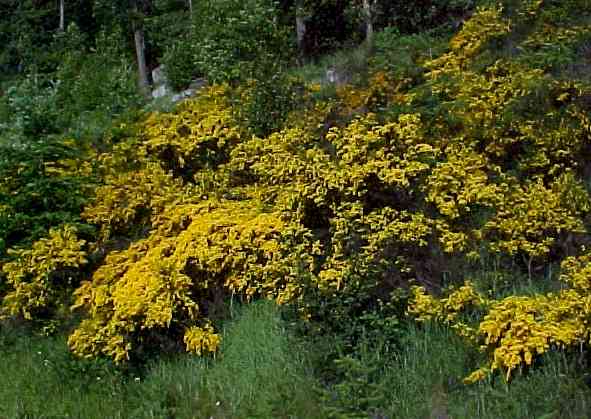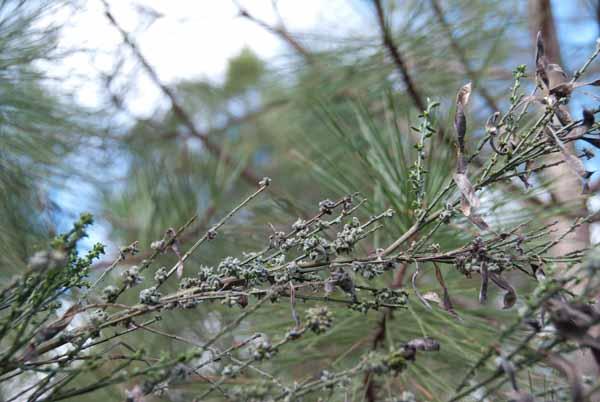A recent find in El Dorado County has weed scientists, land managers, foresters, botanists, and plant conservationists throughout Northern California really excited over a tiny insect-like animal. The broom gall mite (Aceria genistae) which is actually not an insect but more closely related to spiders and ticks has recently taken residence on the invasive plant Scotch broom (Cytisus scoparius). Scotch broom was introduced into North America in the mid-1800s from Europe as an ornamental and for erosion control. The bright yellow flowers and rapid growth has made it a prized ornamental however its ability to out-compete native plants and form dense stands has also made it one of California's worst wildland weeds. Since its introduction it has invaded millions of acres throughout the golden state.
managers, foresters, botanists, and plant conservationists throughout Northern California really excited over a tiny insect-like animal. The broom gall mite (Aceria genistae) which is actually not an insect but more closely related to spiders and ticks has recently taken residence on the invasive plant Scotch broom (Cytisus scoparius). Scotch broom was introduced into North America in the mid-1800s from Europe as an ornamental and for erosion control. The bright yellow flowers and rapid growth has made it a prized ornamental however its ability to out-compete native plants and form dense stands has also made it one of California's worst wildland weeds. Since its introduction it has invaded millions of acres throughout the golden state.
 The exciting news about the mighty mite is that it attacks Scotch broom by forming small growths on the plants buds which greatly reduces the ability for it to grow and reproduce. In some areas, the gall mite has even killed large stands of broom. Native to Europe, the mite was first found on Scotch broom in the Tacoma, Washington and Portland, Oregon regions in 2005. Since that time the mite has become established throughout western Washington and Oregon and even into parts of British Columbia. As of 2013 the mite had been found as far south as Ashland, Oregon with no occurrences in California.
The exciting news about the mighty mite is that it attacks Scotch broom by forming small growths on the plants buds which greatly reduces the ability for it to grow and reproduce. In some areas, the gall mite has even killed large stands of broom. Native to Europe, the mite was first found on Scotch broom in the Tacoma, Washington and Portland, Oregon regions in 2005. Since that time the mite has become established throughout western Washington and Oregon and even into parts of British Columbia. As of 2013 the mite had been found as far south as Ashland, Oregon with no occurrences in California.
In spring 2014, a landowner in the Georgetown area of El Dorado County brought a sickly looking Scotch broom plant to the local U.S. Forest Service office to examine small growths on the branches. Upon inspection, U.S.F.S. botanist Blake 
Engelhardt knew that something was different. Engelhardt brought the plant to the local University of California Cooperative Extension office where farm advisor Scott Oneto identified the sample as a potential gall mite. “We have been watching this mite throughout the Pacific Northwest for the past few years,” says Oneto. The Scotch broom gall mite is a type of eriophyid mite which is considered to be an ideal biological control agent due to the debilitating damage they cause to plants and their largely specialized feeding habits. In addition to the Pacific Northwest, Oneto said “the mite was recently introduced into New Zealand in 2007 to try and combat the invasive weed.”
Since the first detection in El Dorado County back in March 2014, the U.S. Forest Service, UC Cooperative Extension, and County Agriculture Department have been on the lookout for other occurrences. The result has been shocking. The mite has been found in many areas throughout El Dorado, Placer and Nevada counties. How the tiny insect got there is another mystery. The mites are nearly invisible to the naked eye and only measure about 50-60 µm or roughly the width of a human hair. Mites are known to travel long distances by wind currents or by animals, humans and equipment. “It is a bit surprising that we would find the first Scotch broom gall mite in the middle of the state,” says Oneto. “Since Scotch broom occurs throughout the Sierra Nevada, I expected the gall mite to show up closer to the Oregon border. I am guessing that many more finds will be forthcoming.”

Although the mites are nearly invisible to the naked eye, the small growths that the plants make in response to the mite activity is quite noticeable. The small fuzzy masses occur along the length of the stem and can be quite numerous.
“There are nearly 2000 acres of Scotch broom on the Eldorado National Forest, and these infestations cause loss of native plant biodiversity and an increased fire risk,” says Engelhardt. “We spend a considerable amount of time each year treating Scotch broom plants either by herbicide applications or prying them up by the root. I hope these gall mites are hungry! With their help, we'll make much greater progress toward reducing Scotch broom infestations.”
If you suspect evidence of Scotch broom gall mites, the University of California Cooperative Extension asks that you report it on their website http://ucanr.edu/broomgallmite.
For more information about the Scotch broom gall mite contact Scott Oneto at 530-621- 5502 or http://cecentralsierra.ucanr.edu